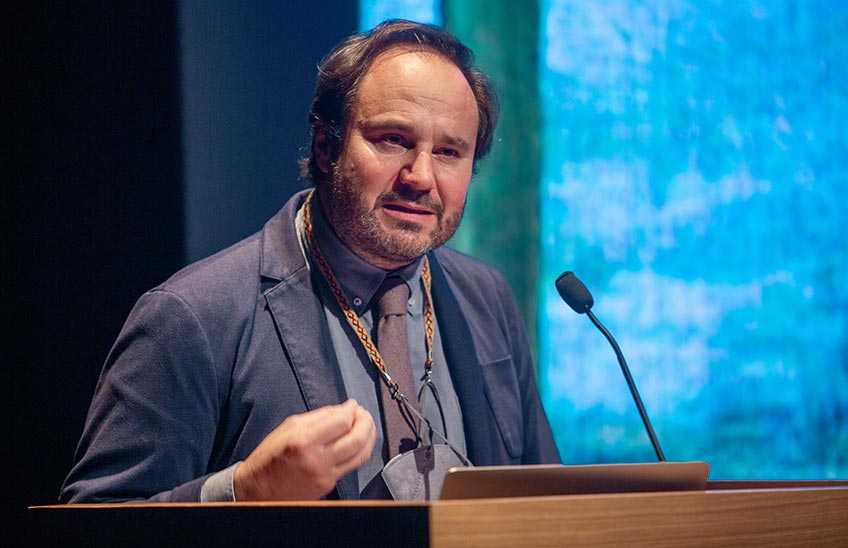Velázquez's technique uncovered in the last session of lecture series organized by the Friends of the Prado Museum Foundation at the University of Navarra.
The lecture was given by Jaime García-Máiquez, technician of the Technical Documentation Office of the Prado Museum and former student of the School of Philosophy and Letters.

FotoManuelCastells/Jaime García-Máiquez gives the fourth and last session of the lecture series that the Friends of the Prado Museum Foundation organizes at the University of Navarra, at partnership with School of Philosophy y Letras.
02 | 03 | 2021
Jaime García-Máiquez, technician of the Technical Documentation Office of the Prado Museum Museo del Pradogave the fourth and last lecture of the Francisco Calvo Serraller cycle at the University of Navarra. Under the degree scroll "Velázquez, troppo vero. The painter and his techniques", García-Máiquez, formerly student of the School of Philosophy and Letters of the academic center, has approached to the assistants the technique, the support and the composition that Velázquez developed in his work, as well as his artisan and human vision of painting.
The speaker began by analyzing the artist's technique during his time in Seville, a period in which "he inherited artistic procedures common to most Sevillian painters of the 17th century, and with them he was able to produce his first masterpieces," he explained. Of his training as an apprentice, first with Francisco de Herrera el Viejo and later with Juan Pacheco, García-Máiquez highlighted "the taste and strategy he achieved with admirable efficiency".
He also discussed the materials used to produce the works: "The support subject to be used was the first material choice of an artist". In the case of Velázquez, as he explained, all the paintings attributed to him are on canvas and specifically, during this stage, "on tablecloth". In this sense, the expert spoke of the study of the supports through radiography: "This technique gives us information about when the canvas was first printed, or about the garlands of tension that were generated when it was anchored for painting: as they remained forever, they give us extremely valuable information, such as the original size of the painting or the subject frame that was used".
Supported by the X-ray of some paintings from his first stage, the speaker has emphasized how Velázquez "is advancing very quickly, with more precise drawings, play of impastos, and density of the grooves". On the other hand, he highlighted his talent for combining the most impastoed areas with those with less paint subject and "his ability to create a range of material textures".
As the expert explained, with his arrival in Madrid Velázquez was evolving in his way of working and understanding painting. "The primer, as well as the support subject , changed during his time at the court. He moved from the reddish-brown earths of Seville to the reds of Madrid", something that affects the optical background "and with which it is possible to delimit which scenes he painted in Seville and which in Madrid".
In the capital, he also got to know Rubens' technique, which was "a turning point in his own technique". As García-Máiquez explained, "the relationship they had is not very well known, but Pacheco tells in Velázquez's biography that he was the only painter he dealt with". Thanks to the primers, we can know that there was a specific contact : "Velázquez primed with white, a fashion that had been lost but that Rubens recovered. When we see a painting later than that meeting, such as The Surrender of Breda, we see the same technique". " Velázquez knew how to play even more than Rubens with white priming, he handled it with great mastery," he added.
Then, and showing the strokes of some of his best known works, the expert has addressed the characteristics of the artist's drawing. "In the works of the 30's, where technically he reached his peak, it seems that the drawing has disappeared. Until the end of his degree program, he will make a very essential but very precise drawing, which sample an evolution, but not a revolution as it had existed before," he said. He also addressed issues such as color, where he explained some elements to take into account when analyzing any of his works, as well as details. "After returning from Italy, Velázquez already possessed a totally unique technique within the Spanish panorama and an absolute technical mastery of his art. He developed this mastery over the following decades, and in this context it is relevant to know how he devised some of his portraits or compositions, how he copied himself or worked in teams with other painters, or why and when he rectified what he had already painted," he explained.
Jaime García-Máiquez holds a doctorate in Art History from the University of Cadiz. researcher in the Technical Documentation Office of the Restoration area of the Prado Museum, where he carries out a scientific analysis of works of art using infrared reflectography and radiography techniques, he is the author of numerous articles on the technique of the great masters. He has also collaborated in the catalogs raisonné of the collections of the Museo del Prado, among which are those dedicated to Bosch, El Greco, Titian, Velázquez and Goya. He also gives lectures on the technical study of works of art in various cultural institutions.
